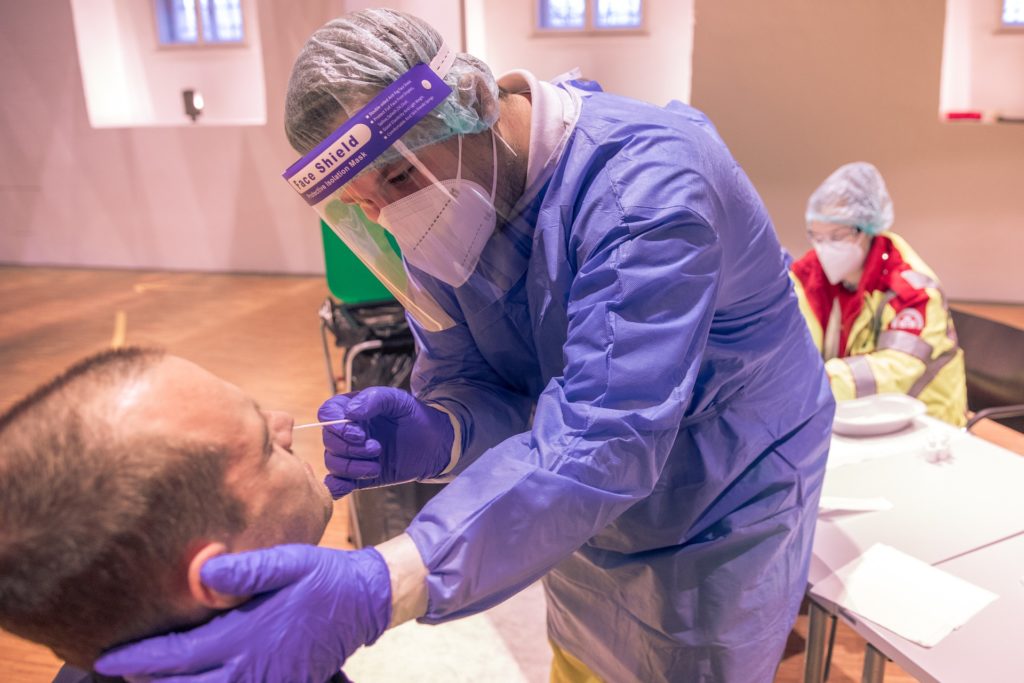By Michael Ollove, Stateline

As more U.S. residents receive their COVID-19 vaccinations, testing for the virus has plummeted, dropping by a third in two months.
This is a positive development wrapped in a potentially worrisome one, public health experts say.
They say the decline reflects diminishing COVID-19 caseloads and suggests fewer Americans are fearful that they have contracted or been exposed to the virus. That relief leaves people less inclined to get tested.
“The big drop-off from January to March is a success story in a lot of ways,” said Christina Silcox, a policy fellow at Duke University’s Margolis Center for Health Policy.
But the dramatic drop in testing could hamper epidemiologists’ ability to spot and stem new surges of the deadly infection, months before enough of the population is vaccinated to reach herd immunity.
“I’m worried about this blind spot starting to form,” said Jennifer Nuzzo, an epidemiologist and senior scholar at the Johns Hopkins Center for Health Security. “We could be slapped with a really disappointing surprise.”
Public health officials say recent calls with the federal Centers for Disease Control and Prevention have focused on the need to convince the public of the continued importance of testing, particularly for people with symptoms and unvaccinated people who may have been exposed to the virus.
“If we don’t do that messaging now we will set ourselves up for spikes and resurgence at this critical time when vaccines aren’t at 100%,” said Lori Tremmel Freeman, CEO of the National Association of County and City Health Officials, who was on one of those CDC calls.
The CDC did not respond to a request for an interview about its concerns about the testing drop-off.
Some states already have urged people with symptoms or possible exposure to get tested. Last week, the Missouri Department of Health and Senior Services reminded residents that as vaccines become more widely available, testing remains an important weapon against the virus.
“We learned quickly in the early days of this public health crisis how important testing was to prevent the spread of the virus,” said Dr. Randall Williams, director of the agency, in a news release. For the remainder of March, Missouri will host community testing events two to three times per week in the Kansas City and St. Louis areas.
The $1.9 trillion COVID-19 relief package that President Joe Biden signed earlier this month includes nearly $48 billion that local and state public health agencies may use to increase testing. The legislation also calls for the development of a national, evidence-based strategy to help public health agencies with testing and contact tracing.
Separately, the package appropriates $1.75 billion to ramp up genomic sequencing, which is used to track burgeoning COVID-19 variants, some of which are more transmissible and might be able to infect people who have COVID-19 antibodies.
The United States has been slow to increase its sequencing. The Rockefeller Foundation, a private foundation that promotes economic opportunity and health care for all, reported only nine states were sequencing even 1% of their positive cases last month. Some epidemiologists say the U.S. should be sequencing 5% of positive cases, the pace set by the United Kingdom, which is considered a leader in sequencing.
“We’re on the right trajectory but really need to scale up,” said Dr. Jonathan Quick, managing director of the Rockefeller Foundation’s pandemic response team.
As of last week, the CDC had reported 5,795 cases of the most concerning variants, a number that doesn’t reflect the true figures, epidemiologists say. CDC officials think the variant that was first detected in the U.K. will become the dominant strain of the disease in the U.S. in the coming weeks.
Testing Drops Everywhere
Data from Johns Hopkins’ Coronavirus Resource Center shows that the number of diagnostic COVID-19 tests administered has dropped significantly in almost every state from the highs of the period between November and January, when surges struck many parts of the country.
There also is great variation among the states in the number of tests conducted relative to the population. According to the CDC, during a seven-day period in mid-March, Vermont conducted the most PCR tests—considered the most reliable diagnostic test for COVID-19—with 10,302 tests per 100,000 people.
Oklahoma performed the fewest, with 428 tests per 100,000.
That week, most states fell in the range between 1,000 and 3,000 tests per 100,000 people. Across the country, the 14-day average of tests administered fell by a third from mid-January through March, according to the Johns Hopkins data.
Unlike last spring and summer, supply problems do not explain the testing decline. Capacity has steadily ramped up and is expected to continue to climb through the end of the year, according to Mara Aspinall, a professor at Arizona State University’s College of Health Solutions and an adviser to the Rockefeller Foundation, which publishes a newsletter tracking testing capacity in the United States.
She said laboratories are no longer overwhelmed by testing demands, which plagued states well into the summer.
“We have state after state telling us they don’t have a backlog any longer,” she said.
Instead, public health officials point to other reasons for the recent decline.
Dr. Clemens Hong, who leads testing in Los Angeles County, said the fall is a positive sign. “Most of the drop is appropriate due to decreased cases,” as well as fewer hospitalizations and deaths, Hong said.
But Nuzzo of Hopkins is less sanguine. Testing started waning even as cases were still rising, she said. She and other public health experts attributed part of the decrease to pandemic fatigue, but also to the public shifting its attention to vaccines.
Freeman of the county and city health officials group agreed. “With the announcement of the vaccine, people are focused on that being the panacea for curing everything,” she said. “I think people are just holding out to get a vaccine rather than get testing.”
Closing Mass Testing Sites
The pivot from testing to vaccines was plainly visible. In mid-January, Los Angeles switched Dodger Stadium from one of the largest testing locations in the country to one of the largest vaccination centers. Other states, such as Florida and Nevada, closed mass testing sites as well, shifting more attention, labor and resources to vaccination.
Los Angeles County officials concluded that maintaining a mass testing center such as Dodger Stadium was less useful than establishing smaller-scale operations in communities, Hong said, particularly sites located near vulnerable populations. The county is moving toward more accessible testing sites where people live and work, he said, in places such as grocery stores, parks and metro stations.
“We’re trying to increase the convenience of testing,” he said.
In California, as well as in some other states, testing volume is linked closely to the level of COVID-19 restrictions. California sets benchmarks for how much testing local jurisdictions should conduct. The areas that fail to hit those marks are assumed to have more infections than they have recorded, which can delay the state’s easing of COVID-19 restrictions there.
Hong said that Los Angeles County has managed to stay above that threshold, but the same isn’t true for Riverside County to the east.
“The state says that if you aren’t doing enough testing, you aren’t finding all your cases,” said Dr. Cameron Kaiser, health officer of Riverside County’s health department.
California is right to set testing benchmarks, Kaiser said, though he objects to what he considers the state’s arbitrary changes in what the benchmarks are.
PCR tests are considered more reliable than rapid antigen COVID-19 diagnostic tests, but they are more expensive, harder to administer and take longer to produce results, although turnaround times have vastly improved since the start of the pandemic.
The drawback of the antigen tests is that positive tests often are not reported back to public health authorities, which means they aren’t serving one of the most important purposes of testing in a pandemic: identifying and contacting residents who have been exposed.
“Losing the contact tracing is the biggest loss from a public health perspective,” said Kelly Wroblewski, director of infectious disease programs at the Association of Public Health Laboratories.
Some areas are trying out environmental testing to detect localized outbreaks of the virus. Arizona, California and Massachusetts are attempting to analyze wastewater. Duke University’s Silcox said another promising alternative would be to routinely swab surfaces in classrooms. If the virus were detected, all teachers and students in that classroom could be tested, rather than testing the entire school.
Many public health experts think the testing lull will be short-lived as more people are vaccinated and the hunger to return to normalcy grows stronger.
They expect testing will be used as a ticket to admission, not only for the opening of schools, but for businesses, houses of worship, entertainment and sporting events. Freeman said that in coming months, businesses likely will set up their own testing programs to entice employees and customers to return. New York Gov. Andrew Cuomo, a Democrat, has talked about Broadway being able to reopen soon with adequate rapid testing in place.
The Quidel Corporation, which manufactures PCR and antigen COVID-19 tests, saw demand shrink by 30% to 40% after the new year, in part, its CEO Doug Bryant said, because many medical facilities had over-ordered as cases mounted after Thanksgiving. The company had invested $300 million to ramp up production, which Bryant acknowledged caused him some anxiety when he watched demand plummet. “Was I going to have egg in my face?” he wondered.
But as the country anticipates a return to normalcy, he has heard from schools and businesses interested in acquiring rapid tests, particularly home-based ones, that would enable them to test students, employees and customers. He said he expects the lull in demand for his products will be short-lived.
“Anyone who has my cell phone number has called,” he said.
Testing, Freeman said, must become ubiquitous. “We still haven’t made testing as easy as it should be for the common person,” she said. “There should be a larger plan that puts testing in the hands of people wherever they go.”


